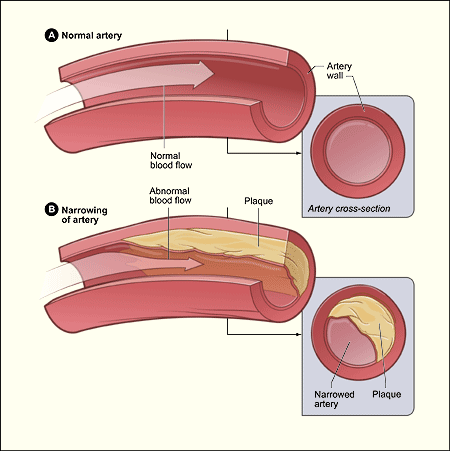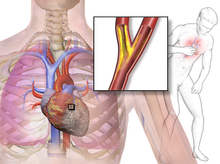Analysis of the disorder
Pathophysiology
Angina is a disorder that has become very common in the current society, especially among those who work in highly stressful environments. Kendal (2010) defines angina as “A chest discomfort due to poor blood flow through the blood vessels in the heart” (p. 37). This disorder occurs when the heart’s oxygen supply does not meet its demand. The common cause of this decrease in supply is the thickening and hardening of the walls of the arteries that supply oxygenated blood to the heart. The figure below shows a normal artery and that which is already affected.

As shown in the diagram above, as the walls get thickened, the radius of the artery is reduced, and this reduces the amount of blood passing through it per given time.
Signs and symptoms
It is important to understand some of the symptoms of angina so that precautionary measures can be taken before it can advance into coronary heart disease. According to Jevon (2012, p. 78), “The most common symptom is chest pain that occurs behind the breastbone or slightly to the left of it.” The figure below shows the region where the pain will be felt, especially in the early stages of unstable angina.

Sometimes the patient may experience crushing chest pain accompanied by short breaths. The pain may spread to the arms, neck, jaws, back, or shoulder. Some patients may experience excessive gas, cases of indigestion or even heartburn.
Progression trajectory
Angina occurs when the coronary arteries experience plaque buildups because of several causative agents. When this happens, this blood vessel narrows, limiting the amount of blood that can flow into the heart. At the initial stages, a patient will have stable angina which is characterized by chest pain when the patient is engaged in any physical exercise. When this is not addressed in time, it progresses to unstable angina where the patient may experience chest pain even when at rest. This is a very critical stage when the arteries have become very narrow. When this is not addressed at this stage, it progresses to coronary heart disease which may become terminal if measures are not put in place to manage it.
Diagnostic testing
Several factors can make medical practitioners suspect angina in a patient. A discomfort that is dull, heavy, or tight and radiates to the back, left arm, neck or jaws is one of the ways of detecting angina. Excessive precipitation after a meal or in cold weather may also be another strong indication of the disease. When testing for the disease, a doctor will need to determine the cholesterol levels of the patient, fasting blood sugar, triglycerides, blood pressure, and pulse rate.
Treatment options
Once it is confirmed that a patient is suffering from angina, appropriate medication is always prescribed. Nitroglycerin is considered the most appropriate medicine when treating angina. It helps in making oxygen more available to the heart. Sometimes the medication may involve the application of balloon angioplasty which helps in widening the artery lumen. When the artery becomes completely irreparably, a doctor may prescribe coronary bypass surgery. This involves bypassing the artery that is constricted by using venous grafts. Each of the three forms of medications is recommended at different stages of the disease’s development. According to Jackson (2011), the best way of managing angina disorder is to detect it at an early stage and then take measures that will help in reversing the process before the disorder can advance further.
Differentiating the disorder from normal development
According to Buttaro, Trybulski, Bailey and Cook (2013), it is necessary to differentiate the disorder from the normal development. It is normal to experience chest discomfort when undertaking heavy physical activity. However, when the discomfort happens even when one is taking slight exercise or physical activity, then it should be a warning to the affected person. It is also common to find cases where there is acute chest pain that is not caused by any physical impact or emotional pain. These symptoms should be detected and treated as abnormal developments.
Physical and psychological demands placed on the patient and family
According to Buttaro (2013), angina is caused by several factors such as stress, smoking cigarettes, excessive intake of alcohol, or other such related complications. To win a war against this disorder, there are many physical and emotional demands needed on the patient and the family members. The patient needs to avoid being stressed, and the family has a role in this too. They will need to eliminate stressors and help the patient overcome some of the issues causing stress.
The patient will need the willpower to overcome the habit of smoking and excessive alcohol taking. Members of the family can help in this by recommending psychotherapists who may help the patient to overcome these habits. The family members will need to treat the patient as a special person, especially when combating the disease. Issues that may cause anxiety or any form of anticipation should be avoided at all costs. The patient may also need to fight obesity by regularly engaging in physical activity to boost the health of the heart and coronary arteries.
Key concepts to be shared to manage the disorder
When the patient has received medication, it is expected that it will take some time for the disorder to be eliminated. The patient will need some specific information from the doctors that will help him or her to manage the disorder. The patient will need to know about types of food that should be avoided, and those that should be taken regularly. This information should also be shared by the family members, especially when the types of food recommended are not the patient’s favorite. The patient will need to be informed that stress is dangerous for people with the disorder. They need to know how to address stressors, and members of the family may need to know how they can help the patient in their effort to manage stress. This will help in achieving the desired outcome in managing this complication.
Key interdisciplinary team personnel needed to achieve an optimal outcome
When addressing this disorder, a team of interdisciplinary personnel is needed to effectively manage the disorder. A team of cardiologists will be needed to address the physical problems in the coronary arteries of the patient. A team of nutritionists will be needed to give strict advice on the type of food that should be taken by the patient to reduce the accumulation of cholesterol in the blood. Stress has been singled out as one of the leading causes of angina.
A psychologist plays an important role in helping the patient to manage stress. A psychologist will be able to determine the levels of stress in the patient, and measures that the patient and family members can use to fight stress. Cardiovascular surgeons will be needed when addressing cases of advanced angina, also known as unstable angina. They are needed to conduct coronary artery bypass graft or angioplasty on such patients.
Nurses will be needed when the patient is admitted. They will administer the medicines, study the progress of the patient, and help in various activities to ensure the safety and comfort of the patient for the period he or she will be in admission. The personnel will need to coordinate with one another closely because they are playing separate but interrelated roles. For instance, the psychologist may help the cardiologist to determine if the cause of the disorder is stress. If the patient is not a smoker and has avoided all other practices which are regarded as risk factors, then the doctor may not be in a position to explain the cause of the disorder. However, this problem may be solved when the psychologist can explain the cause from the perspective of excessive stress. This coordination will help in improving the outcome in managing the disorder.
Facilitators and barriers to optimal disorder management
When managing this disorder, it is important to understand that there are facilitators and barriers to optimal management of the disorder. Facilitators to the optimal management of the disorder may be individuals or objects that promote the recovery of the patient. A good working environment, supportive family members, regular exercise, and an informed diet are strong facilitators of optimal disease management.
Engaging in community work in groups of those who suffer from the same complication may be very beneficial. When they engage in such group works, they can share and encourage one another, thus eliminating stressors in their lives. They are also able to share their ways of managing their disorder, On the other hand, issues such as obesity, smoking, and excessive intake of alcohol may reduce chances of getting a better outcome. Stressful work environment, unsupportive families, and irresponsible lifestyle may work against achieving good results.
Strategies to overcome the identified barriers
There are a number of barriers identified in the section above that should be avoided to ensure that optimal results are achieved when managing this disease. The issue of obesity can be addressed through physical exercise. This will help in shedding away excess fat from the body. Sometimes it may be necessary for the patient to quit the current profession if it is considered to be the leading cause of stress in his or her life. The patient may be encouraged to take a less stressful job. When addressing the problem of unsupportive families, the patient may need to find a way of staying away from them to reduce levels of stress. A psychologist may be needed to help the patient to overcome the problem of addiction to smoking or alcohol taking.
References
Buttaro, T. M. (2013). Primary care: A collaborative practice. St. Louis, Mo: Elsevier/Mosby.
Buttaro, T., Trybulski, J., Bailey, P. & Cook, J. (2013). Primary Care. New York: Elsevier.
Jackson, G. (2011). Angina. London: M. Dunitz.
Jevon, P. (2012). Angina and heart attack. Oxford: Oxford University Press.
Kendal, R. (2010). The angina monologues. Auckland Park, South Africa: Jacana Media.
